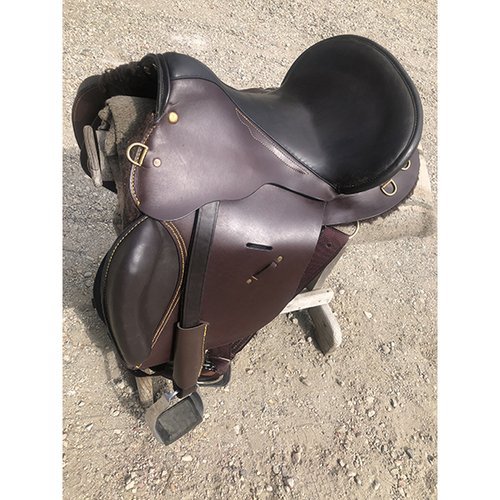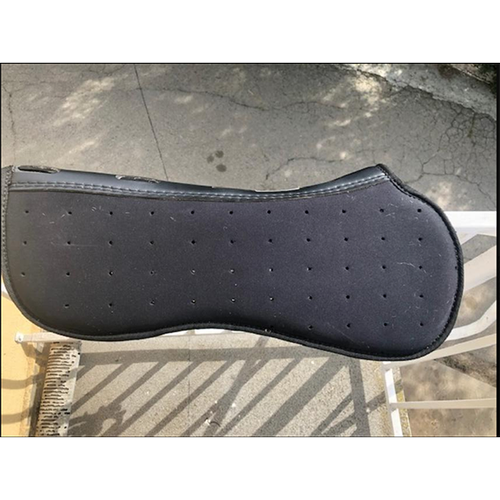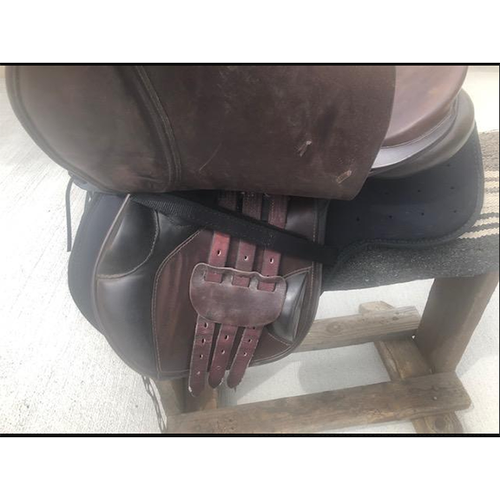The Colin English Saddle
Colin didn’t invent this saddle.
It is a remake of the very first Australian stock saddle made over 200 years ago by one Syd Hill, a runaway from London.
The first such saddle was built on a dressage frame. Thereafter the “knee pads” rose up the leading edge of the pommel becoming “Poleys”, so named because these new saddles resembled “poled” cows — steers with their horns cut off thus featuring just the ears. The higher Poleys enabled cattlemen to stay seated while chasing at a flat gallop after wild cattle. Crashing was the norm. Still they are often called “knee pads.”
So the Colin English is a remake of the very first Aussie saddle made.
The knee pad is shaped to properly receive a knee at the downhill plunge.
The seat is wide and generous giving all day back support and security on rough trails. The COLIN ENGLISH is the first re-design of the traditional English saddle in 300 years. The need for it occurred to Colin when he was given a 9 year-old 17-hand French jumping horse — because it was bucking off riders. Explains Colin: I put my fleece panel Australian stock saddle on the horse and he did act up a little, but nothing too serious. I was actually quite puzzled by his bad reputation. Still I rode him a dozen more times in the stock saddle, working him on very rough and precipitous trails washed out in the Malibu hills after the floods that followed the big Woolsey fire. He soon got used to the trails — something he had never experienced — and I was thrilled. A perfect, very expensive horse — for free! Given his speed and reputed jumping ability I thought he would make a great steeplechase horse, a race I love, but did not, until now, have the right horse for. So I put on my English cross country saddle, to get him used to it before I started jumping. That’s when things started to go bad. He bucked, he spun, tossed his head. Now I was really confused. I had taken my English saddle apart and perfectly fit it to his back, so it couldn’t be a saddle issue. Or so I thought. I mentioned this to my riding buddy, Dr Ed Wagner, a chiropractor to the Malibu rich and famous. He suggested he test the horse with sensitive equipment he uses to measure electric flow in people. The meter went crazy in the wither area. Ed suggested it might be a saddle fit problem. Impossible, I said, because I fit the saddle personally. I don’t make mistakes like that. There was a perfect sweat pattern after every ride. I wondered aloud if it could be a neurological issue. Dr Wagner didn’t think so. Two days later, I put the stock saddle back on and within minutes he moved perfectly again. Dr Wagner was right. It WAS a saddle problem., I was shocked. Then it occurred to me, that the English saddle had not changed in 300 years, but in that time people in first world countries, myself included, had increased in weight by at least 30 percent. I measured the bearing surface of my Australian stock saddle and it is 300 square inches.. The bearing surface of my English saddle is 150 inches. The math was clear. I was exerting almost twice the bearing pressure on my horse with my English saddle as I did with my Australian stock saddle. Now I had ridden this English saddle on many other horses for years and never had a problem — that I knew of. But the French jumping horse is grey with skin so delicate his legs take on the color of the grass he is walking in. I weigh 170 lbs. So in my stock saddle I would have been exerting about .7 pounds per square inch (psi). But in my English saddle the psi would have been about 1.25 — still under the 1.5 psi generally considered the red line for pressure on the back of a horse. But for my grey horse, it was still too much. So I redesigned the English saddle, made one in my size and was rewarded with a horse as happy riding this COLIN ENGLISH as he was in my Australian saddle. Now he is in training for his first cross-country race this spring — in my COLIN ENGLISH, a saddle much more suited to jumping than the Australian stock saddle. I know this will solve back issues for other English riders, especially if they weigh 100 pounds more than myself. Another great discovery I have made is the COLIN ENGLISH is way more close contact than my traditional English saddle. I can feel the horse, and he can feel me — a big plus on the approach to a jump. At left that is me taking a cross country water jump in my COLIN ENGLISH.”
The last photos show the COLIN ENGLISH fitted with no-pinch Campdraft leathers.,and finally the very last picture shows the underside of the Colin English against the underside of a regular English Saddle.
THE TRUTH IS IN THE MATH.
At left the regular English saddle has a bearing surface of 155 square inches
At right the Colin English has a bearing surface of 320 square inches, translating to
TWICE the comfort for the horse, and closer contact gives the rider more security and horse contact.
The close contact panels are built on an adjustable web suspended wood and metal tree. The rigging is Western, with center fire latigos for stability, the solid stirrup suspension bar is in the dressage position. Saddle weighs 12 lbs.
To see a testimonial from one of the first to own this new saddle click HERE
Colin didn’t invent this saddle.
It is a remake of the very first Australian stock saddle made over 200 years ago by one Syd Hill, a runaway from London.
The first such saddle was built on a dressage frame. Thereafter the “knee pads” rose up the leading edge of the pommel becoming “Poleys”, so named because these new saddles resembled “poled” cows — steers with their horns cut off thus featuring just the ears. The higher Poleys enabled cattlemen to stay seated while chasing at a flat gallop after wild cattle. Crashing was the norm. Still they are often called “knee pads.”
So the Colin English is a remake of the very first Aussie saddle made.
The knee pad is shaped to properly receive a knee at the downhill plunge.
The seat is wide and generous giving all day back support and security on rough trails. The COLIN ENGLISH is the first re-design of the traditional English saddle in 300 years. The need for it occurred to Colin when he was given a 9 year-old 17-hand French jumping horse — because it was bucking off riders. Explains Colin: I put my fleece panel Australian stock saddle on the horse and he did act up a little, but nothing too serious. I was actually quite puzzled by his bad reputation. Still I rode him a dozen more times in the stock saddle, working him on very rough and precipitous trails washed out in the Malibu hills after the floods that followed the big Woolsey fire. He soon got used to the trails — something he had never experienced — and I was thrilled. A perfect, very expensive horse — for free! Given his speed and reputed jumping ability I thought he would make a great steeplechase horse, a race I love, but did not, until now, have the right horse for. So I put on my English cross country saddle, to get him used to it before I started jumping. That’s when things started to go bad. He bucked, he spun, tossed his head. Now I was really confused. I had taken my English saddle apart and perfectly fit it to his back, so it couldn’t be a saddle issue. Or so I thought. I mentioned this to my riding buddy, Dr Ed Wagner, a chiropractor to the Malibu rich and famous. He suggested he test the horse with sensitive equipment he uses to measure electric flow in people. The meter went crazy in the wither area. Ed suggested it might be a saddle fit problem. Impossible, I said, because I fit the saddle personally. I don’t make mistakes like that. There was a perfect sweat pattern after every ride. I wondered aloud if it could be a neurological issue. Dr Wagner didn’t think so. Two days later, I put the stock saddle back on and within minutes he moved perfectly again. Dr Wagner was right. It WAS a saddle problem., I was shocked. Then it occurred to me, that the English saddle had not changed in 300 years, but in that time people in first world countries, myself included, had increased in weight by at least 30 percent. I measured the bearing surface of my Australian stock saddle and it is 300 square inches.. The bearing surface of my English saddle is 150 inches. The math was clear. I was exerting almost twice the bearing pressure on my horse with my English saddle as I did with my Australian stock saddle. Now I had ridden this English saddle on many other horses for years and never had a problem — that I knew of. But the French jumping horse is grey with skin so delicate his legs take on the color of the grass he is walking in. I weigh 170 lbs. So in my stock saddle I would have been exerting about .7 pounds per square inch (psi). But in my English saddle the psi would have been about 1.25 — still under the 1.5 psi generally considered the red line for pressure on the back of a horse. But for my grey horse, it was still too much. So I redesigned the English saddle, made one in my size and was rewarded with a horse as happy riding this COLIN ENGLISH as he was in my Australian saddle. Now he is in training for his first cross-country race this spring — in my COLIN ENGLISH, a saddle much more suited to jumping than the Australian stock saddle. I know this will solve back issues for other English riders, especially if they weigh 100 pounds more than myself. Another great discovery I have made is the COLIN ENGLISH is way more close contact than my traditional English saddle. I can feel the horse, and he can feel me — a big plus on the approach to a jump. At left that is me taking a cross country water jump in my COLIN ENGLISH.”
The last photos show the COLIN ENGLISH fitted with no-pinch Campdraft leathers.,and finally the very last picture shows the underside of the Colin English against the underside of a regular English Saddle.
THE TRUTH IS IN THE MATH.
At left the regular English saddle has a bearing surface of 155 square inches
At right the Colin English has a bearing surface of 320 square inches, translating to
TWICE the comfort for the horse, and closer contact gives the rider more security and horse contact.
The close contact panels are built on an adjustable web suspended wood and metal tree. The rigging is Western, with center fire latigos for stability, the solid stirrup suspension bar is in the dressage position. Saddle weighs 12 lbs.
To see a testimonial from one of the first to own this new saddle click HERE
Colin didn’t invent this saddle.
It is a remake of the very first Australian stock saddle made over 200 years ago by one Syd Hill, a runaway from London.
The first such saddle was built on a dressage frame. Thereafter the “knee pads” rose up the leading edge of the pommel becoming “Poleys”, so named because these new saddles resembled “poled” cows — steers with their horns cut off thus featuring just the ears. The higher Poleys enabled cattlemen to stay seated while chasing at a flat gallop after wild cattle. Crashing was the norm. Still they are often called “knee pads.”
So the Colin English is a remake of the very first Aussie saddle made.
The knee pad is shaped to properly receive a knee at the downhill plunge.
The seat is wide and generous giving all day back support and security on rough trails. The COLIN ENGLISH is the first re-design of the traditional English saddle in 300 years. The need for it occurred to Colin when he was given a 9 year-old 17-hand French jumping horse — because it was bucking off riders. Explains Colin: I put my fleece panel Australian stock saddle on the horse and he did act up a little, but nothing too serious. I was actually quite puzzled by his bad reputation. Still I rode him a dozen more times in the stock saddle, working him on very rough and precipitous trails washed out in the Malibu hills after the floods that followed the big Woolsey fire. He soon got used to the trails — something he had never experienced — and I was thrilled. A perfect, very expensive horse — for free! Given his speed and reputed jumping ability I thought he would make a great steeplechase horse, a race I love, but did not, until now, have the right horse for. So I put on my English cross country saddle, to get him used to it before I started jumping. That’s when things started to go bad. He bucked, he spun, tossed his head. Now I was really confused. I had taken my English saddle apart and perfectly fit it to his back, so it couldn’t be a saddle issue. Or so I thought. I mentioned this to my riding buddy, Dr Ed Wagner, a chiropractor to the Malibu rich and famous. He suggested he test the horse with sensitive equipment he uses to measure electric flow in people. The meter went crazy in the wither area. Ed suggested it might be a saddle fit problem. Impossible, I said, because I fit the saddle personally. I don’t make mistakes like that. There was a perfect sweat pattern after every ride. I wondered aloud if it could be a neurological issue. Dr Wagner didn’t think so. Two days later, I put the stock saddle back on and within minutes he moved perfectly again. Dr Wagner was right. It WAS a saddle problem., I was shocked. Then it occurred to me, that the English saddle had not changed in 300 years, but in that time people in first world countries, myself included, had increased in weight by at least 30 percent. I measured the bearing surface of my Australian stock saddle and it is 300 square inches.. The bearing surface of my English saddle is 150 inches. The math was clear. I was exerting almost twice the bearing pressure on my horse with my English saddle as I did with my Australian stock saddle. Now I had ridden this English saddle on many other horses for years and never had a problem — that I knew of. But the French jumping horse is grey with skin so delicate his legs take on the color of the grass he is walking in. I weigh 170 lbs. So in my stock saddle I would have been exerting about .7 pounds per square inch (psi). But in my English saddle the psi would have been about 1.25 — still under the 1.5 psi generally considered the red line for pressure on the back of a horse. But for my grey horse, it was still too much. So I redesigned the English saddle, made one in my size and was rewarded with a horse as happy riding this COLIN ENGLISH as he was in my Australian saddle. Now he is in training for his first cross-country race this spring — in my COLIN ENGLISH, a saddle much more suited to jumping than the Australian stock saddle. I know this will solve back issues for other English riders, especially if they weigh 100 pounds more than myself. Another great discovery I have made is the COLIN ENGLISH is way more close contact than my traditional English saddle. I can feel the horse, and he can feel me — a big plus on the approach to a jump. At left that is me taking a cross country water jump in my COLIN ENGLISH.”
The last photos show the COLIN ENGLISH fitted with no-pinch Campdraft leathers.,and finally the very last picture shows the underside of the Colin English against the underside of a regular English Saddle.
THE TRUTH IS IN THE MATH.
At left the regular English saddle has a bearing surface of 155 square inches
At right the Colin English has a bearing surface of 320 square inches, translating to
TWICE the comfort for the horse, and closer contact gives the rider more security and horse contact.
The close contact panels are built on an adjustable web suspended wood and metal tree. The rigging is Western, with center fire latigos for stability, the solid stirrup suspension bar is in the dressage position. Saddle weighs 12 lbs.
To see a testimonial from one of the first to own this new saddle click HERE



































